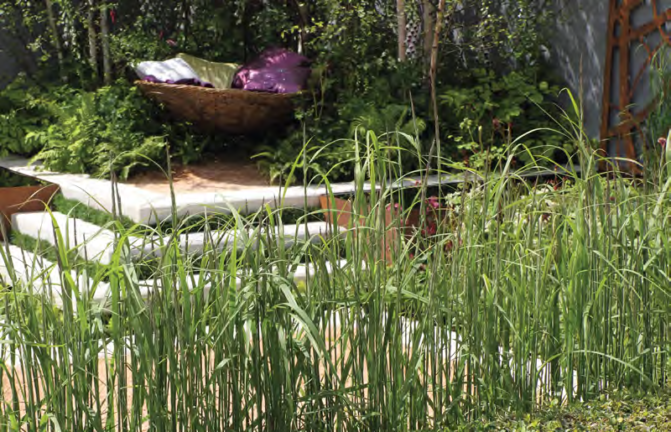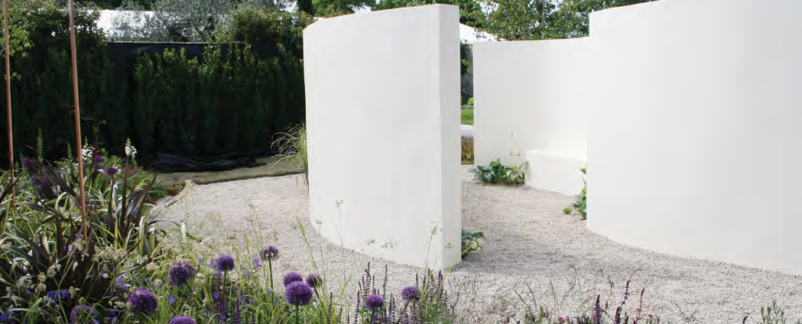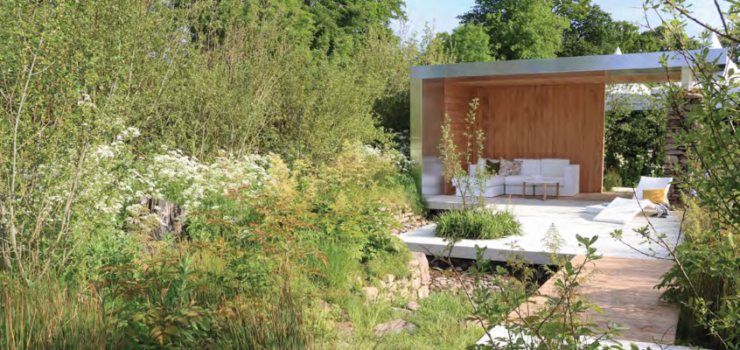HORTICULTURECONNECTED talks to the experts
| Creating a gold medal-winning show garden requires many things: time, energy, skill, knowledge, experience, determination, creativity, commitment, a thick skin and an eye for detail. For the uninitiated, the process from initial idea to completed garden can be daunting and fraught with obstacles, pitfalls, setbacks and disappointments. Even for the most experienced, the process can present a real challenge, but one they’re prepared to overcome.
The gardens at this year’s Bloom in the Park have come under some significant fire. While several were of a very high standard, others were criticised for poor design, weak planting, and from my own perspective, a number were simply too compromised by sponsors to be considered gardens at all. While Irish garden design has some significant ground to make up, the sector has something almost unique to Ireland, and which was most evident during the Bloom garden build period. Irish garden design is familial in nature and underpinned with friendship, comradery and a genuine willingness to help, encourage and assist. Irish designers are always willing to lend a hand, advise, and is often the case, share plants, materials and expertise. To build on this culture and with a view to helping show garden applicants achieving gold in 2015, I asked three top designers and gold medal recipients to share their thoughts on how they go about creating show-stopping gardens. BARRY LUPTON |
 JANE MCCORKELL
JANE MCCORKELL
PLAN, ORGANISE AND DON’T COMPROMISE.
Building a show garden is an emotional rollercoaster ride of the extreme variety. The thought of designing and planning for a show is enough to make me run to the hills screaming. That is, until an opportunity to do a garden comes up. And there is the problem. Show life is exciting and frightening, exhilarating and exhausting, but most of all very beneficial to anyone who wants to be a professional garden designer. There are a number of stages that comprise the process of creating a show garden.
The beginning or phase 1, when engaging and securing your client/sponsor can really push you out of your comfort zone. You could be working with a number of professionals all with their own opinions and providing you with plenty of marketing jargon, at all times thinking about how they can brand. It’s easy to say yes to the many demands that a sponsor may put on you. But as a professional, you must learn to say NO if the suggestion goes against the real purpose of the project. As a designer, you must listen to the client/sponsor, get back to the basics of garden design and study their brief – translate this into a garden. Remember, show gardens are a little bit of inspiration for the visitor and a whole lot of photographic opportunity for you as a designer. I try to get the client to see a show garden as an opportunity to give back something beautiful to their customers, a thank you if you like.
“The thought of designing and planning for a show is enough to make me run to the hills screaming”
Once the design has been signed off by the client you are into the organisation and procurement phase. There is only one captain on this project and the responsibility all come back to you as the designer, therefore it’s ok to be a control freak. Once the day of the build starts all procurement must be in place. It is too late to be going shopping when you are in the construction phase. I often feel that too many people underestimate the importance of plant material and how much of it you need to fill a garden. It is not something that should be left to the last minute or rushed. Engage and listen to the nursery grower when deciding on plants. Your plants should be getting ready for the show in the background for months in advance.

I would always have a construction schedule in place before we arrive on-site, continuously referring back to the schedule which probably drives the contractors crazy, but I don’t care. You never know what can happen on the journey, broken trees, broken arms and broken contractors.
Phase three is construction, everything is organised. Do not make changes unless you know that what is going in is wrong. It’s ok to ask your colleagues what they think, but remember too many opinions will only unnerve you. Make decisions and be happy with them. Don’t risk or compromise the finish. This piece of work should represent just how important detail is to you. Stick to the work schedule, and be there! You need to be there to check that you are happy with paving patterns, proportions of the overall layout, position of trees etc…etc… etc… Remember it’s all your fault.
Phase four is completion, and probably the part I really hate. Medals – never easy. Regardless of what you have received please ask for feedback. Part of the design process is taking constructive criticism. It’s not personal, take it on board and learn from it. Add it to the many things you will learn about yourself throughout the journey. ✽
Jane McCorkell is one of Ireland’s leading garden designers and recipient of numerous gold medals at Bloom. You can learn more about her landscape and garden work by visiting her website at www.janemccorkelllandscape.ie

|
 FIANN Ó NUALLÁIN
FIANN Ó NUALLÁIN
BLOOM IS NO NORMAL GIG
I and my partner Lisa try not to think about medals at all. Our focus is not strictly commercial horticulture and we’re not selling a landscape service. So we’re free to focus on what we want: engaging people with horticulture. For us, success is telling a good story through design and concept. Our show garden at the inaugural Bloom (2007) was created to share a message – to raise awareness of the role of outreach gardening programmes in getting early school leavers back into education. We were awarded a silver-gilt (no golds that year for medium-sized gardens) and also awarded the best in the category. It wowed the crowds and got lots of press and media attention. We didn’t think as first timers we would get a medal, up against the big boys with big budgets and professional crews. We were operating with a few helpers and a credit card with a 3k limit! Starting with such a meagre budget necessitated us thinking laterally. Such thinking is a requirement for any first-timer. No one knew who we were, so sponsorship was a challenge. To get around this we grew our own plants. Unfortunately, the judges didn’t recognise that endeavour, telling us during feedback that it was the plants which marked us down from gold.
My advice on the budget is, have a contingency plan – no matter how you break it down between hard landscaping, plants, labour etc. something always goes over budget, and remember that even with a sponsor some items need to be paid for well in advance of receiving that sponsorship cheque. If money is tight or sponsorship falls though then just think what colour a rendered boundary wall might be painted compared to the dream of real marble or polished copper facades.
“Negative feedback on planting was a dilemma that some faced at Bloom this year”
Negative feedback on planting was a dilemma that some faced at Bloom this year. Personally I think some suppliers should share in the responsibility rather than just dismiss it as a schoolboy error on the part of designers. Having created show gardens at every Bloom since its inception I’m considered a veteran, but even this year I had 1lt pots arriving as ‘mature specimens’, and substitutions too and that’s after face to face consultations and frequent check backs. I am not sure that everybody in the industry understands what Bloom is, and how reputations are on the line. Bloom is no normal gig, it is not a client with the patience to wait for plants to grow, or the tolerance to accept a box hedge in place of a lavender hedge. It’s a show, judged on a brief, open to the public for five days and then it’s over. It has to look established and at peak perfection on day one. I know there are specialist growers but that too is a matter of budget/sponsorship. Bloom show gardens promote phenomenal plant sales of 1 and 2ltr specimens but for designers to keep that happening we need the availability of 10, 30 and even 50 litre plants. I would rather source here than in Holland or Italy. So for certain quarters of the sector is it time to up the game? And for new to Bloom designers, get a good grower or nursery on board.
A design brief for Bloom is put in about eight months before the show opens. And while you can make amendments later on, the more mishaps and changes you make, the less likely it is that the garden will compare with your initial submission. This negatively impacts on medals. If you’re preparing a submission, you really need to be aware of that.
In terms of the brief, it is best to think of a Unique Selling Point and stick with it, deliver it in four sentences, not four pages, and don’t promise what you may have to retract on judging day when it’s too late for excuses. If your intention is to deliver a green roof encrusted with alpine gems and bejewelled with Burren natives in full flower, just say ‘green roof’ in case all you can get or afford is a roll-out of sedums. If your garden is a story (for a charity) or tells a story (urban biodiversity), then it’s easy to find the USP, and easy for the media to understand.
Sponsorship is the perennial challenge for designers and 2014 was no exception. Some designers got poor medals for what the judges effectively dismissed as trade stands, while others were branded, but less obviously. Is the latter good design or just a hands-off sponsor? I have designed gardens at Bloom for all manner of clients, addressing a huge range of topics. Some have been easy, others difficult. I have had sponsors who demanded a change in colour palette two days before judging which is incredibly challenging. Other sponsors enhance your experience at Bloom.
Sponsorship is not a charity donation to a designer. It is a marketing investment and a wonderful promotional opportunity. In marketing parlance, it affords potential for ‘a positive emotional message’ and a ‘face to the product’. But inexperienced designers and ill-informed marketers can lose sight of the value that strong design can deliver. And that’s the thing – how do we ensure continued sponsorship and support for Bloom show gardens without compromising? One way to start is to nail down your USP and brief from the word ‘go’. A clear intention will get attention; from there it’s about managing expectation.
Thankfully Bloom has stayed true to an ethos of being egalitarian, of supporting and encouraging show gardens and engaging spaces by a diversity of talent and perspectives. We came from a horticultural therapy background and were permitted to create gardens alongside top landscape architects and seasoned designers. Many of them had won awards previously. Long may there always be new faces and novice gardens at Bloom. Bloom needs that. ✽
You can learn more about Fiann and his work with gardens and plants by visiting both www.theholisticgardener.com and www.inspiringgardens.ie

GERARD MULLEN

BLOOM IS A FANTASTIC SHOWCASE FOR GARDEN DESIGNERS IN IRELAND.
I have been involved since its inception with a small garden in 2008. It has been fantastic to watch the event grow and develop over the years. Creating a show garden at Bloom is a unique experience and one which always leaves me looking forward to my next show garden. As a designer, it offers the opportunity to showcase your work on a national scale and meet with and work alongside peers and friends in the industry. Bloom’s show gardens are focussed on promoting garden design and new ideas in garden design, and should never lose this focus. While show gardens will always remain intrinsically linked to commercial sponsorship it is important to manage and maintain the balance between marketing and design integrity.
Creating a successful show garden requires the ability of the designer to adapt and apply their creative talents in a slightly different guise to their normal working day. The show garden space is very much a theatrical display – a stage set – which captures a moment in time of a living garden space.
“The show garden space is very much a theatrical display, which captures a moment in time of a living garden space”
So what are the key factors for success? Well, there are many and there is no doubt that creating a show garden is a unique balancing act for designers combining a range of disciplines from planning, construction techniques, project management, budget and promotional marketing and so on. Personally I think that any designer contemplating undertaking a show garden project needs to start with attention to some basic but vital factors in the process.
EVERYONE LIKES A GOOD STORY
Successful show gardens always have a clear story in their delivery, a strong narrative threaded through the garden which reveals itself to the visitor. Such narratives make up the glue that binds garden elements together, achieving a balanced and successful space.
When approaching an exhibition project, I always aim to have a very clear visual image in my head for the garden, an identified personal story that I am excited to tell and importantly that I believe in. The inspiration driving these stories can range from wanting to communicate a concept in plant textures, combinations of materials or observed elements from our landscape. It is these visuals that always drive my design process and the decision making process behind the garden.
As a designer, it can take time to develop the skills to decipher your narrative, and more importantly disseminate this with clarity to the public via the show garden environment. A show garden that has a weak message will always fail to fully capture the imagination of the viewer. Equally, a strong message poorly translated will not achieve impact.
Any designer attempting a show garden should take time to develop clarity on their story. Take sufficient time to think through the content thoroughly and ask difficult questions of your plans. Evolve the brief, brainstorm concepts, and refine your thought process.
Continue to cut and paste ideas until you form a structured story. You should be able to summarise your garden theme in a few sentences. If not, you are overcomplicating your brief or simply not confident in telling your story.
GIVE TIME AND FOCUS TO WRITING YOUR BRIEF
All show gardens at Bloom require the designer to submit a written brief as part of the judging process. Writing a brief not only requires a designer to be clear on their story but also to be able to document this clearly in written format for the judges. A poorly written brief and lack of clarity on aims for the garden will inevitably result in the judges working harder to understand the garden and evaluate accordingly.
Self-awareness of one’s abilities is key. Know your strengths and weaknesses. You may be a great designer but if you struggle with descriptive writing then you need to outsource this task. A clear and well-crafted brief sets out the aims in writing of your show garden before you even begin. It is a step that will help to cement your garden story and any grey areas will be exposed. A clear brief enables the judges to understand your concept and evaluate your implementation.
Writing a detailed design brief will help to develop your garden narrative into a fully formed story that will help drive the design process. A clear brief will always assist a project to run smoothly, and importantly it will continually inform the decision-making processes as the project progresses.

KEEP IT SIMPLE
Most designers tend to have a huge bank of ideas stored up, collected from daily observations and their design backgrounds. There is an endless world of possibilities available for incorporation into this once-off show garden creation. However, to achieve success it is vitally important to avoid the trap of pouring a plethora of ideas into one garden. This can be especially difficult for the show garden newcomer. A key skill to develop is restraint. The confidence in one’s design abilities will help to maintain focus and keep it simple.
DEVELOP YOUR PLANTING SCHEME
Personal observation of Bloom show gardens over the years continually exposes a weakness around planting schemes. A planting scheme must be part of your garden story and be threaded through your narrative at the design brief phase. Failure to account for such a key element will inevitably compromise a garden.
A clear image of your planting before beginning will always help inform your decisions and scheme. It seems that as the final days of planting approach designers inevitably drift, losing sight of their brief and being distracted by the bright lights of all those lovely blooms carpeting the nursery grounds. To this end, unfortunately, every year, there are a few gardens that following weeks of hard graft and impeccable construction work devolve into a space that resembles what I imagine the collision of two nursery lorries on the M50 would look like. A confusing explosion of plants that don’t belong.
Planting requires that key skill mentioned previously – restraint – the practiced ability to keep things clear and simple. My tip is to always have a copy of your design brief to hand and review it regularly as each construction phase progresses. If you have new ideas or changes during construction always defer to your original brief and review decisions accordingly. ✽







